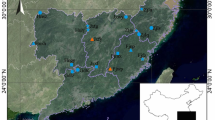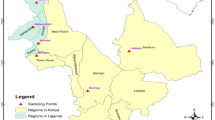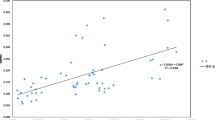Abstract
Genetic diversity influences the fitness of species and provides variation for adaptation. Garcinia paucinervis Chun et How (Clusiaceae) is an endangered species with important ecological, medicinal and ornamental values endemic to Southwest China and Northern Vietnam, whose populations were severely fragmented in island habitats and population sizes were influenced by human. The assessment of genetic variation of G. paucinervis is anticipated to provide essential information for efficient conservation strategies. In this study, a suite of population genetics tests and analyses were used to investigate genetic diversity and structure of the 11 natural populations (a total of 360 individuals) of G. paucinervis in Guangxi and Yunnan Provinces, China, based on genotypes at 14 loci. Our results revealed a low to moderate genetic diversity in G. paucinervis remnants (HE = 0.487, I = 0.924, AR = 3.420). The global inbreeding coefficient (FIS = 0.004) showed significant deviation from Hardy–Weinberg equilibrium, implying that the risk of inbreeding depression accompanied by heterozygote deficiency was probably due to severe habitat fragmentation and decreasing population sizes. Significant bottlenecks were detected in two populations. There has been little recent exchange of genes between most of the population pairs. Mantel test revealed that the genetic distance was not related to the geographical distance, suggesting a limitation of gene flow. A population from Yunnan Province could be classified as an independent cluster separated from the other populations, which should be considered as a prior conservation unit.




Similar content being viewed by others
References
Ávila-Díaz I, Oyama K (2007) Conservation genetics of an endemic and endangered epiphytic Laelia speciosa (Orchidaceae). Am J Bot 94:184–193
Botstein D (1980) Construction of a genetic linkage map in man using restriction fragment length polymorphism. Am J Hum Genet 32:314–331
Brookfield JF (1996) A simple new method for estimating null allele frequency from heterozygote deficiency. Mol Ecol 5:453
Cao PJ, Yao QF, Ding BY, Zeng HY, Zhong YX, Fu CX, Jin XF (2006) Genetic diversity of Sinojackia dolichocarpa (Styracaceae), a species endangered and endemic to China, detected by inter-simple sequence repeat (ISSR). Biochem Syst Ecol 34:231–239
Carvajal-Rodriguez A (2018) Myriads: p-value-based multiple testing correction. Bioinformatics 34:1043–1104
Carvajal-Rodríguez A, de Uña-Alvarez J, Rolán-Alvarez E (2009) A new multitest correction (SGoF) that increases its statistical power when increasing the number of tests. BMC Bioinformatics 10:209
Carvalho DC, Oliveira DAA, Sampaio I, Beheregaray LB (2014) Analysis of propagule pressure and genetic diversity in the invasibility of a freshwater apex predator: the peacock bass (genus Cichla). Neotrop Ichthyol 12:105–116
Chan CH, Robertson HA, Saul EK, Nia LV, Phuong LV, Kong XC, Zhao Y, Chambers GK (2011) Genetic variation in the kakerori (Pomarea dimidiata), an endangered endemic bird successfully recovering in the Cook Islands. Conserv Genet 12:441–447
Chapuis MP, Estoup A (2007) Microsatellite null alleles and estimation of population differentiation. Mol Biol Evol 24:621–631
Chung MY, Nason JD, López-Pujol J, Yamashiro T, Yang BY, Luo YB, Chung MG (2014) Genetic consequences of fragmentation on populations of the terrestrial orchid Cymbidium goeringii. Biol Conserv 170:222–231
Cullingham CI, James PMA, Cooke JEK, Coltman DW (2012) Characterizing the physical and genetic structure of the lodgepole pine × jack pine hybrid zone: mosaic structure and differential introgression. Evol Appl 5:879–891
Dardengo JFE, Rossi AAB, Varella TL (2018) The effects of fragmentation on the genetic structure of Theobroma speciosum (Malvaceae) populations in Mato Grosso, Brazil. Rev Biol Trop 66:218–226
Deacon NJ, Cavender-Bares J (2015) Limited pollen dispersal contributes to population genetic structure but not local adaptation in Quercus oleoides forests of Costa Rica. PLoS ONE 10:e0138783
Doyle JJ (1987) A rapid DNA isolation procedure for small quantities of fresh leaf tissue. Phytochem Bull 19:11–15
Evanno G, Regnaut S, Goudet J (2005) Detecting the number of clusters of individuals using the software STRUCTURE: a simulation study. Mol Ecol 14:2611–2620
Fagen LI, Xia N (2005) Population structure and genetic diversity of an endangered species, Glyptostrobus pensilis (Cupressaceae). Bot Bull Acad Sin 46:155–162
Francisco-Ortega J, Santos-Guerra A, Kim SC, Crawford DJ (2000) Plant genetic diversity in the Canary Islands: a conservation perspective. Am J Bot 87:909–919
Frankham R (2005) Genetics and extinction. Biol Conserv 126:131–140
Fu LG (1991) China plant red data book. Science Press, Beijing, pp 736–737 (in Chinese)
Funk WC, McKay JC, Hohenlohe PA, Allendorf FW (2012) Harnessing genomics for delineating conservation units. Trends Ecol Evol 9:489–496
Guichoux E, Lagache L, Wagner S, Chaumeil P, Léger P, Lepais O, Lepoittevin C, Malausa T, Revardel E, Salin F, Petit RJ (2011) Current trends in microsatellite genotyping. Mol Ecol Resour 11:591–611
Honjo M, Ueno S, Tsumura Y, Washitami I, Ohsawa R (2004) Phylogeographic study based on intraspecific sequence variation of chloroplast DNA for the conservation of genetic diversity in the Japanese endangered species Primula sieboldii. Biol Conserv 120:211–220
Hu G, Zhang ZH, Yang P, Zhang QW, Yuan CA (2017) Development of microsatellite markers in Garcinia paucinervis (Clusiaceae), an endangered species of karst habitats. Appl Plant Sci 5:1600131
Jost LOU (2008) Gst and its relatives do not measure differentiation. Mol Ecol 17:4015–4026
Jump AS, Peñuelas J (2006) Genetic effects of chronic habitat fragmentation in a wind-pollinated tree. Proc Natl Acad Sci USA 103:8096–8100
Kalinowski ST, Taper ML, Marshall TC (2007) Revising how the computer program CERVUS accommodates genotyping error increases success in paternity assignment. Mol Ecol 16:1099–1106
Kang M, Jiang M, Huang H (2005) Genetic diversity in fragmented populations of Berchemiella wilsonii var. pubipetiolata (Rhamnaceae). Ann Bot 95:1145–1151
Karron JD (1997) Genetic consequences of different patterns of distribution and abundance. In: Kunin WE, Gaston KJ (eds) The biology of rarity: causes and consequences of rare-common differences. Chapman Hall, London, pp 174–189
Kramer AT, Ison JL, Ashley MV, Howe HF (2008) The paradox of forest fragmentation genetics. Conserv Biol 22:878–885
Lande R (1999) Extinction risks from anthropogenic, ecological, and genetic factors. In: Landweber LF, Dobson AP (eds) Genetics and the extinction of species: DNA and the conservation of biodiversity. Princeton University Press, Princeton, pp 1–22
Liang RL (2015) Garcinia paucinervis: Guangxi ironwood. Forestry Guangxi 32:24–25 (in Chinese)
Lowe AJ, Boshier D, Ward M, Bacles CFE, Navarro C (2005) Genetic resource impacts of habitat loss and degradation; reconciling empirical evidence and predicted theory for neotropical trees. Heredity 95:255–273
Mantel N (1967) The detection of disease clustering and a generalized regression approach. Can Res 27:209–220
Neel MC, Commings MP (2003) Effectiveness of conservation targets in capturing genetic diversity. Conserv Biol 17:219–229. https://doi.org/10.1046/j.1523-1739.2003.01352.x
Nei M (1978) Estimation of average heterozygosity and genetic distance from a small number of individuals. Genetics 89:583–590
Nybom H (2004) Comparison of different nuclear DNA markers for estimating intraspecific genetic diversity in plants. Mol Ecol 13:1143–1155
Peakall ROD, Smouse PE (2006) GENALEX 6: genetic analysis in Excel. Population genetic software for teaching and research. Mol Ecol Resour 6:288–295
Pritchard JK, Stephens M, Donnelly P (2000) Inference of population structure using multilocus genotype data. Genetics 155:945–959
Reisch C, Poschlod P, Wingender R (2003) Genetic variation of Saxifraga paniculata Mill. (Saxifragaceae): molecular evidence for glacial relict endemism in central Europe. Biol J Lin Soc 80:11–21
Rousset F (2008) Genepop’007: a complete re-implementation of the genepop software for Windows and Linux. Mol Ecol Resour 8:103–106
Segarra-Moragues JG, Palop-Esteban M, González-Candelas F, Catalán P (2005) On the verge of extinction: genetics of the critically endangered Iberian plant species, Borderea chouardii (Dioscoreaceae) and implications for conservation management. Mol Ecol 14:969–982
Slatkin M (1994) Gene Flow and Population Structure. In: Real LA (ed) Ecological genetics. Princeton University Press, Princeton, pp 3–17
Spencer CC, Neigel JE, Leberg PL (2000) Experimental evaluation of the usefulness of microsatellite DNA for detecting demographic bottlenecks. Mol Ecol 9:1517–1528
Szpiech ZA, Jakobsson M, Rosenberg NA (2008) ADZE: a rarefaction approach for counting alleles private to combinations of populations. Bioinformatics 24:2498–2504
Tautz D (1989) Hypervariability of simple sequences as a general source for polymorphic DNA markers. Nucleic Acids Res 17:6463–6471
Templeton AR (2010) Introduction to conservation genetics. Cambridge University Press, Cambridge, p 56
Toure D, Burnet JE, Jianwei Z (2010) Rare plants protection importance and implementation of measures to avoid, minimize or mitigate impacts on their survival in Longhushan Nature Reserve, Guangxi Autonomous Region, China. J Am Sci 6:221–238
Van Oosterhout C, Hutchinson WF, Wills DPM, Shipley P (2004) MICRO-CHECKER: software for identifying and correcting genotyping errors in microsatellite data. Mol Ecol Resour 4:535–538
Wang ZF, Cao HL, Wu LF, Guo Y, Mei QM, Li M, Wang Y, Wang ZM (2017) A set of novel microsatellite markers developed for an economically important tree, Dracontomelon duperreanum, in China. Genet Mol Res 16:gmr16029578
Wilson GA, Rannala B (2003) Bayesian inference of recent migration rates using multi-locus genotypes. Genetics 163:1177–1191
Yang L, Liu ZL, Li J, Dyer RJ (2015) Genetic structure of Pinus henryi and Pinus tabuliformis: natural landscapes as significant barriers to gene flow among populations. Biochem Syst Ecol 61:124–132
Yao XH, Ye QG, Kang M, Huang HW (2007) Microsatellite analysis reveals interpopulation differentiation and gene flow in the endangered tree Changiostyrax dolichocarpa (Styracaceae) with fragmented distribution in central China. New Phytol 176:472–480
Yu XM, Zhou Q, Qian ZQ, Li S, Zhao GF (2006) Analysis of genetic diversity and population differentiation of Larix potaninii var. chinensis using microsatellite DNA. Biochem Genet 44:483–493
Zhai SH, Yin GS, Yang XH (2018) Population genetics of the endangered and wild edible plant Ottelia acuminata in southwestern China using novel SSR markers. Biochem Genet 56:1–20
Zhang DX, Hewitt GM (2003) Nuclear DNA analyses in genetic studies of populations: practice, problems and prospects. Mol Ecol 12:563–584
Zhang X, Liu B, Zhou Y, Liu ZZ, Li P, Long CL (2015) Potential ornamental plants in Clusiaceae from China. Acta Hort 28:233–238
Zhang JJ, Chai SF, Lü SH, Shi YC, Jiang YS, Wei X (2017) The habitat characteristics and analysis on endangering factors of rare and endangered plant Garcinia paucinervis. Ecol Environ Sci 26:582–589 (in Chinese)
Zhang JJ, Wei X, Wu SH, Chai SF, Lü SH, Han Y (2018a) Morphological differentiation of Garcinia paucinervis fruits and seeds and effects of exogenous substances on its seed germination and seedling growth. Guihaia 38:509–520 (in Chinese)
Zhang YY, Shi E, Yang ZP, Geng QF, Qiu YX, Wang ZS (2018b) Development and application of genomic resources in an endangered palaeoendemic Tree, Parrotia subaequalis (Hamamelidaceae) From Eastern China. Front Plant Sci 9:246
Acknowledgments
We would like to express our sincere thanks to Mr. Shi-hong Lü, Dr. Yan-cai Shi, Mr. Yun-sheng Jiang and Mr. Jian-min Tang for the field observation and collecting samples, as well as Dr. Ming Kang for comments on this manuscript. This project was supported by Natural Science Foundation of Guangxi (2015GXNSFDA13915), Guangxi Science and Technology Base and Special Fund for Talents (AD17129022), and National Natural Science Foundation of China (31600306).
Author information
Authors and Affiliations
Corresponding authors
Additional information
Publisher's Note
Springer Nature remains neutral with regard to jurisdictional claims in published maps and institutional affiliations.
Rights and permissions
About this article
Cite this article
Zhang, JJ., Wei, X., Chai, SF. et al. Genetic diversity and population structure of Garcinia paucinervis, an endangered species using microsatellite markers. Conserv Genet 20, 837–849 (2019). https://doi.org/10.1007/s10592-019-01176-2
Received:
Accepted:
Published:
Issue Date:
DOI: https://doi.org/10.1007/s10592-019-01176-2




